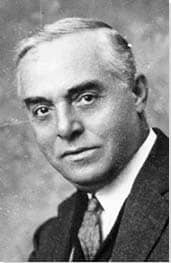Summary of Carlo Carrà
Carrà was one of the driving forces behind the rise of the Italian Futurists, both through his contribution as an artist, and as co-author/author of two of the movement's most important manifestos. With the onset of the World War I, he abandoned the Futurist cause and became, with Giorgio de Chirico, a pioneer of Metaphysical Painting (Pittura Metafisica) in which he brought a dreamlike quality to mundane interiors and city squares. His involvement with this movement was relatively short lived, however, and after the 1920s he devoted himself to works in the realist idiom including monumental figures and naturalistic landscapes. Between 1941 and 1952 he acted as professor of painting in Milan, his tenure coinciding with a mature painterly style that became somewhat looser with a preference for freer, almost Impressionistic, brushwork.
Accomplishments
- Carrà had a profound influence on the Futurist concept of Dynamism. In his 1913 manifesto, "The Painting of Sounds, Noises and Smells", he formally introduced the group to the idea of synaesthesia, that being a perceptual phenomenon that relates to the idea that exposure to one external stimulus (say, sound or smell), induces a parallel visualization (say, color). It was a vigorous and liberating concept that stimulated the practice of many within the Futurist fraternity.
- Although Metaphysical Painting was the co-creation of Giorgio de Chirico and Carrà, arts writer Lorenzo Berto referred to Carrà as the "absolute protagonist" of the movement; his art representing an attempt to "paint the unseen". The dreamlike quality of Carrà's Metaphysical works, the use of ambiguous symbolic language, and the placing of objects in incredulous settings, was highly innovative and a direct influence on the Surrealist movement.
- Carrà's idea of synaesthesia helped turn around modernist attitudes towards color. Color had been disparaged (by the Cubists, for instance) as a decorative device that distracted from the true subject of the painting. Carrà helped bring about an attitude that re-evaluated the role of color. For him, and those who followed, the task was to employ color as an expressive element; an element that could bring a unique and special energy to dynamic painting.
- Carrà's nationalistic and artistic ideas evolved from the cerebral Metaphysical Painting through to the regionalist Strapaese group (formed by Giorgio Morandi). The values of the Strapaese ("super country") movement were linked to nationalism (ergo, fascism ) and a simplified art form that rebuked modernist experimentation in favor of art that celebrated Italy's rural identity. It led Carrà in his mature years to a more contemplative art through which he transformed Italian landscape painting into what he called "poems full of space and dreams".
The Life of Carlo Carrà
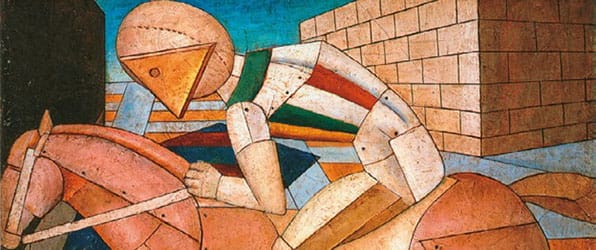
Carrà stated, "For me, art is a continuous process; it is in a state of continuous spiritual crisis which finds its own balance", and, for Carrà, Futurism had been just "but one of these crises".
Important Art by Carlo Carrà
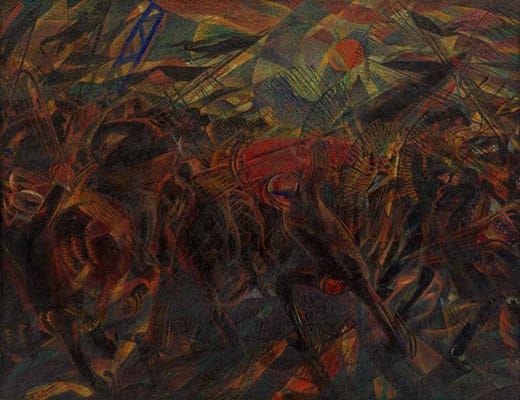
Funerale dell'Anarchico Galli (Funeral of the Anarchist Galli)
Art historian Christine Poggi says of this painting, "Strident effects of contrasting color, dazzling light, distortions of perspective, and brushwork [fuse] figure and ground". Carrà's painting is now considered an exemplar of early Italian Futurism. It depicts the funeral of Milanese anarchist and labor organizer Angelo Galli who was shot and killed by police in the Italian General Strike of September 1904 (a strike that was called by the Chambers of Labor as a response to the killing of many striking workers in previous strikes). The government feared that the anarchists in attendance would turn Galli's funeral into a political demonstration and refused them entrance into the cemetery. What resulted was a violent struggle between the anarchist and the police.
Carrà was one of those in attendance at the funeral, and later recalled "In front of me I saw the coffin, covered over and over with red carnations, which rocked threateningly back and forth on the shoulders of the bearers; I saw how the horses began to shy, how sticks and lances clashed, such that it seemed to me that sooner or later the coffin would fall to the ground and be trampled on by the horses". In his painting, the red form at the center represents the casket, and although various human forms can be made out in the chaotic composition, it is dominated by abstract linear brushstrokes, which can be understood as "lines of motion", a common element of much Futurist art. Moreover, several figures carry black anarchist flags, representing at once the concepts of nationalism, revolution, and violent protest, all of which were of key importance to the Futurists.
Arts writer Phillip Barcio explains that "One of the essential goals of Futurist painting was to convey movement and energy on the canvas; an effect they called Dynamism [...] The use of sharply angled lines became fundamental to Dynamism, as a way to convey speed, movement and power". Carrà himself stated that "The acute angle is passionate and dynamic, expressing will and a penetrating force". He had expressed this strong sense of powerful movement in earlier works, such as Station a Milano (Milan Station) (1909), but, as Barcio notes, Carrà's angles in Funeral of the Anarchist Galli are "more severe, placing the utmost importance not on the subject but on conveying the chaos and energy of the scene [His] goal was complete freedom from realisms. The operative word in this painting wasn't funeral, it was anarchist. The point of it wasn't to show a funeral, or to convey an image of any specific event; it was to convey the ideas of chaos and energy. Through an evolution toward total abstraction, Carrà felt he could attain a pure display of Dynamism".
Oil on canvas - Museum of Modern Art, New York
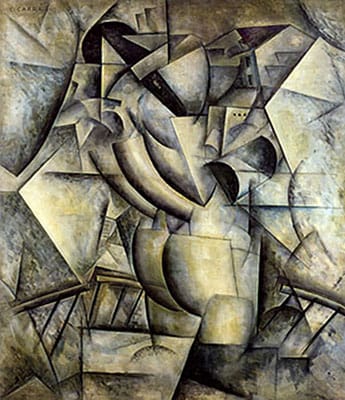
Simultaneità, La donna al balcone (Simultaneity, Woman on the Balcony)
With this work, Carrà blends elements of Futurism with Cubism. Painted in subdued hues of black, gray, brown, and yellow, the figure of a "woman on a balcony" is nearly completely abstracted and fragmented. As arts writer Phillip Barcio explains, "Carrà's painting [...] seems Cubist, but it doesn't show multiple perspectives. Rather it uses Cubist shapes to show motion. A similar idea is evident in Carrà's painting The Cyclist, from 1913, which combines abstracted Cubist forms with repetition to convey the sense of a bicycle racer in motion".
Although Carrà developed connections with the Cubists while in Paris in 1911, he believed that Cubism, in his words, "lacked vitality". Barcio writes that Carrà "thought Cubism stopped the world and painted it, whereas he wanted the world to continue moving while he captured the feeling of that movement on the canvas". Feeling much more of an allegiance to the Futurists, Carrà stated, "We [the Futurists] insist that our concept of perspective is the total antitheses of all static perspective. It is dynamic and chaotic in application, producing in the mind of the observer a veritable mass of plastic emotions".
Oil on canvas - Collection R. Jucker, Milan, Italy
Penelope
Painted the same year he met painter Giorgio de Chirico, Penelope signals the period when Carrà was transitioning from Futurism to Metaphysical Art (which the two men developed in collaboration). Within a small, claustrophobic room with black and white checkerboard-pattern tiled floors, the figure of Penelope is composed of shapes that recall Cubism in terms of their geometric forms and fragmented arrangement. Yet the figure also nods at Futurism, as her parts are, as arts writer Matthew Rudman puts it, "composed of riveted machine components, fragmented shapes interlocking in arcing lines".
However, this painting moves decisively away from Futurism as the figure of Penelope and her environment are static, rigid, and stable. Writes Rudman, "Penelope appears as a model or statue rather than a being in motion". In this way, de Chirico's influence is evident, as Carrà's Penelope exudes a sense of surrealist, simplicity, and artificiality that were hallmarks of de Chirico's paintings. In fact, Penelope featured in the Valori Plastici exhibition tour of Germany in 1921. As historian Emanuele Greco writes, the magazine "presented metaphysical painting both as an innovative language of the avant- garde and as well as a language that followed the Italian artistic tradition [and] a strategic move to describe the language of Metaphysics to the public in different ways".
Greco explains how "The critical debate in the pages of Valori Plastici had three main branches: modern art, which the artists of the group aimed to redefine in anti-impressionistic and anti-avant-gardist terms; Italian recent tradition, particularly of the nineteenth century; and finally, a more ancient Italian art, especially of the fourteenth and fifteenth centuries [...] The first branch, which regarded the redefinition of modern art, includes the reflection of the interpretation and the meaning of the Metaphysical painting of de Chirico and Carrà, which will subsequently lead to assuming the connotation and significance of national painting".
Oil on canvas - Private collection
La Musa Metafisica (The Metaphysical Muse)
With La Musa Metafisica, Carrà was fully engaged with the Metaphysical Painting style. In this image he includes a mannequin (a motif he appropriates from de Chirico's paintings). On the left of the frame, Carrà's white, featureless, mannequin is dressed in a white pleated skirt, and a white top and sweater, she holds a sports racket in her right hand and a ball in her left. To her left, stands a board featuring a map of Greece (de Chirico was Greek-Italian) and a target in the bottom-left corner, a painting of a bland urban landscape, and behind it, a tall conoid construction made up of panels of green, yellow, black, and red. These incongruous and absurd objects are packed into a small room, with doors on the rear and right-hand walls, and a cross hanging on the rear wall.
Arts writer Phillip Barcio writes that "Metaphysical Painting was the conceptual forerunner of several abstract movements that came after it. Through this innovative style, Carrà was attempting to paint the unseen. He was trying to arrive at the idea of something rather than painting the thing itself". He adds that "The dreamlike imagery in Carrà's Metaphysical Paintings directly influenced the aesthetic of the 1920s Surrealist movement. And perhaps more significantly, these paintings depended on a symbolic language of forms to communicate abstraction [...] More than Futurism, maybe this was Carrà's greatest legacy; the suggestion that abstraction can be achieved through symbolic or conceptual means, putting objects in contexts that challenge their meaning in an effort to create something new".
Greco, meanwhile, observes that, "One of the most interesting aspects of Metaphysical painting is the difficulty of providing a critical definition of it, and therefore of locating it in twentieth-century art history. As is well known, Metaphysical painting was, for a long period of time, considered by critics in an ambiguous manner: it could be read as an avant-garde movement, or a movement completely in line with tradition. Nowadays, we consider Metaphysical painting as an artistic conception close to the historical avant-gardes; nevertheless, in many aspects it is different and parallel, and sometimes even antithetical, to those avant-gardes, in particular Cubism and Futurism".
Oil on canvas - Palazzo Brera, Milan, Italy
Il Figlio del Costruttore, (The Builder's Son)
In another of his Metaphysical works, Carrà presents a boy, who, like the mannequin in Metaphysical Muse, is clothed all in white (a sailor's uniform here) and holds a tennis racket in his right hand and a white ball in his left. Beside him on the ground stands a brown rectangular box, upon which leans a wooden pole. On the right-hand wall of the small gloomy room hangs what appears to be a banner or painting of vertical white and red stripes. Behind the boy there is an open door through which we see nothing but black empty space.
Curator Ester Coen said of this work that "The animated vitality of futurist lines in Carrà's work are replaced by isolated objects, fixed by an esoteric, emblematic and enigmatic language". Carrà and de Chirico both produced "esoteric" paintings, however, as arts writer Matthew Rudman notes, "Unlike de Chirico, whose metaphysical paintings were often shot through with sinister undertones, Carrà's work is more tranquil and occasionally playful in its combination of elements". But, as arts writer Lorenzo Berto cautions, the work, that may at first seem almost banal, carries a "disorienting nature, as the lighting and shadows are not consistent, creating a sense of alienation and indeterminacy".
Berto analyzed the symbols in the painting, for instance, proposing that "the half-open door is linked to two situations faced by Carrà in those years: the call to arms [and] the hospitalization shared with Giorgio de Chirico at the neurological hospital of Villa del Seminario [...] In other words, we wonder if Carrà meant that opening onto a dark space as a symbol of a dramatic story, which has been overcome but not forgotten [...] We feel closed in that narrow space, all mental and personal of the artist, continuing to ask ourselves the same questions: where does that door lead? Will we ever be able to cross it?".
Oil on canvas - Private Collection, Turin, Italy
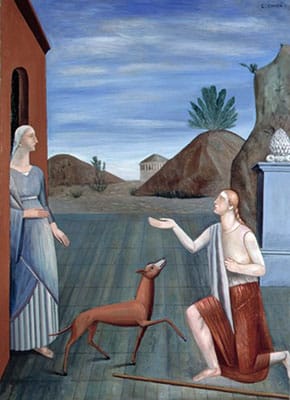
Le Figlie di Loth (Lot's Daughters)
After his short-lived engagement with Metaphysical Painting, Carrà turned to creating more historically inspired, simplified, and realistic works, influenced by a newfound love of the art of Massaccio, as well as Giotto, to whom he referred as "the artist whose forms are closest to our manner of conceiving the construction of bodies in space". In Lot's Daughters, the two women face one another, with one wearing a blue dress, appearing pregnant, with her right hand placed upon her belly, and standing in the arched doorway of a brown house, and the other woman wearing a brown skirt and white top kneeling on one knee on the ground outside the house, with her right arm outstretched, palm turned upward, and her left hand resting upon her chest. A wooden pole (likely a traveling stick) lies in front of her, and a slim brown dog stands between the two women, facing to the right, looking up at the one who kneels. The background is comprised on a desert landscape with a few rocky outcroppings and plants, and beyond that, a circular building or roundhouse.
Both women wear wistful looks upon their faces. According to the biblical episode in the book of Genesis, Lot and his family attempt to flee the city of Sodom as it is being destroyed by God. However, his wife is turned into a pillar of salt as she turns to look back at the devastation, and only Lot and his daughters survive, making it to a remote location where they lived on their own. This isolation led the two daughters to engage in incestuous acts with their father to reproduce. Thus, the forlorn expressions on the women's faces can be understood as their shared shame for the trials they have suffered, and the sinful acts they have committed.
As an admirer of the way that Giotto painted figures and scenes that were proudly solid and static, Carrà emulated this by isolating forms and figures in a simple setting, using diffuse lighting. The entire work is executed in shades of blue, green, and brown, and the forms are geometric in nature. Although Carrà is moving towards his later Realist phase, he is not quite there yet. For instance, the lighting is not naturalistic, and the perspective lines that run along the joints of the tiles on the ground appear forced (and recall similar floor patterns from his Metaphysical paintings).
Oil on canvas - Museum of Modern and Contemporary Art of Trento and Rovereto, Italy
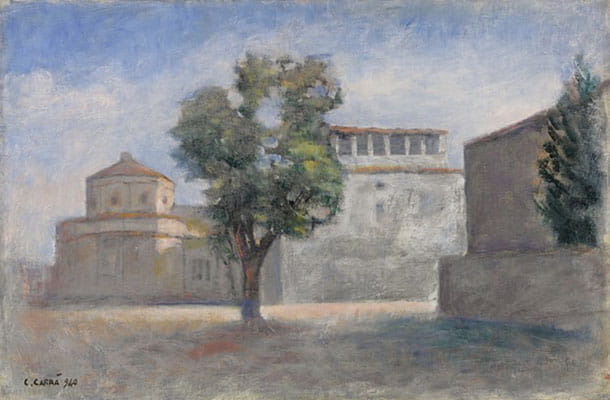
Veduta della Rotonda del Brunelleschi
By the end of the 1920s, after decades of experimentation with avant-garde techniques, Carrà had settled into the style with which he would continue for the remainder of his life: realistic, contemplative landscapes executed with feathery brushstrokes and soft colors. It is generally assumed that his traumatic experiences during the war motivated him to seek a return to tranquility and that through painting he wanted to carry out what he called "a transformation of the landscape into a poem full of space and dreams".
The Sorgente Group Foundation comments, that "this is precisely the spirit with which, in 1940, [Carrà] made this glimpse of the Florentine church of Santa Maria degli Angeli, better known as the Rotonda del Brunelleschi. Despite being an urban landscape, the church is immersed in a rarefied environment, dominated by absolute silence, as if it were painted early in the morning. An environment completely free from signs of life where only the same quiet of its pleasant rural landscapes or its silent seascapes dominates. To remind us that even in a chaotic environment, such as the center of a city, one can gather in an interior metaphysical reflection, free from any disturbing element".
Oil on canvas - Collezione della Fondazione Sorgente Group, Rome, Italy
Biography of Carlo Carrà
Childhood
Little is known of Carlo Carrà's early life. He was born in Quargnento, Piedmont, in Northern Italy, and began drawing at the age of seven. When he was still just twelve years old, he left home to work as an interior decorator and by the age of eighteen he was traveling Europe painting murals, and even decorated pavilions at the Exposition Universelle (Paris World Fair) in 1889. It was in the French capital, indeed, that he first became acquainted with the modern art scene. He was particularly taken by the works of Renoir and Cézanne.
While in Paris he also became conversant with ideas of radical political figures, especially the Russian revolutionary anarchist Mikhail Bakunin and the philosopher/economist Karl Marx. He then travelled on to London where he stayed for a few months. In London he fell in love with the artwork of English Romantic painter J.M.W. Turner and developed contacts with exiled Italian anarchists who encouraged him to return to Italy to study fine arts. Following their advice, he arrived in Milan in 1901.
Education and Early Training
In 1903 Carrà enrolled in the arts and crafts school in Castello Sforzesco, and, in 1906, began studying night classes at the Accademia di Brera in Milan under the tuition of the painter Cesare Tallone. To support his studies, he continuing to work as an interior decorator during the day. Historian Phillip Barcio writes, "In art school he was exposed to Divisionism, a technique that placed colors next to each other on a canvas rather than mixing them beforehand, as a way of tricking the eye into completing the picture. The concept of Divisionism was a profound departure from the realistic painting techniques that had preceded it, and it opened Carrà's mind to the possibilities of abstraction". Carrà remained at the Accademia di Brera until 1908.
In 1909 Carrà met the poet Filippo Marinetti, and painter and sculptor Umberto Boccioni, both of whom urged him to join them in a new movement they were forming. In 1910, he, with Boccioni, painter, composer Luigi Russolo, and painter and poet Giacomo Balla, co-authored the Manifesto of Futurist Painters. The same year, he also put his name to the Technical Manifesto of Futurist Painting, the second in an unprecedentedly long list of manifestos for a modernist movement. The Futurists believed that industrialization, machines and technological advancements, such as mass media technologies, trains, automobiles, and airplanes, as well as urbanization, patriotism, chaos, violent revolution, and the rise of the working class, were the way of the future, and promoted these concepts through their art. Speed and dynamic motion was the underlying theme within Futurist works, represented through various means, including blurring, and repetition of forms, as well as styles influenced by the geometric compositions being explored by the Cubists.
Barcio observes that one of Carrà's first attempts at Dynamism was his 1910 painting, Stazione A Milano. The principle of Dynamism in painting was that the image should convey a sense of vigorous activity that would, in turn, symbolize societal and aesthetic progress. In this work, writes Barcio, the artist "expresses the hive of activity surrounding a train station as a train is rolling in. Though somewhat representational, the painting reduces the human figures to ambiguous forms. The dominant elements in the image are light, smoke and the oncoming machine. The feeling is one of humanity passing into shadow as glorious industry barges forward in a cloud of ferocious fire and smoke".
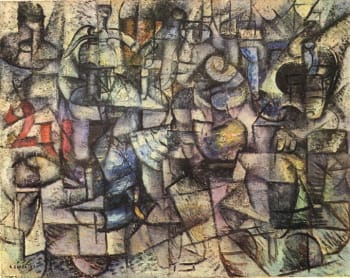
Barcio writes, "While the Futurists were focused on Dynamism, the Cubists were also attempting to convey an enhanced sort of realism, one that involved multiple perspectives of a single subject. Carrà felt Cubist paintings lacked vitality. He thought Cubism stopped the world and painted it, whereas he wanted the world to continue moving while he captured the feeling of that movement on the canvas. Speaking on behalf of the Futurists, indeed, Carrà himself stated, "We insist that our concept of perspective is the total antitheses of all static perspective. It is dynamic and chaotic in application, producing in the mind of the observer a veritable mass of plastic emotions". Carrà mastery of these techniques was abundantly evident in one of his first masterpieces, Funeral of the Anarchist Galli (I funerali del anarchico Galli), (1910-11), in which he captured the chaotic charge of an anarchic crowd.
In 1913 - on the back of the Futurist's groundbreaking Paris exhibition of the previous year - Carrà published his own manifesto, The Painting of Sounds, Noises and Smells, in which he wrote about the process of synaesthesia: "We Futurist painters maintain that sounds, noises, and smells are incorporated in the expression of lines, volumes and colors just as lines, volumes and colors are incorporated in the architecture of a musical work. Our canvases will therefore express the plastic equivalents of the sounds noises and smells found in theaters, music-halls, cinemas, brothels, railway stations, ports, garages, hospitals, workshops, etc., etc". Although Marinetti was the movement's de-facto leader, Carrà's manifesto showed him to be one of the most important members the Futurist movement.
Mature Period
Around the start of the First World War, Carrà strayed from a strict adherence to the principles of Futurism, stating "For me, art is a continuous process; it is in a state of continuous spiritual crisis which finds its own balance ... Futurism was but one of these crises". His work at this time became more studied, with a tighter focus on formal matters. He found new inspiration in the art of children and other "outsiders", and began creating simplified, realistic still lifes. While in military service in Ferrara in 1917, he met Greek-Italian painter Giorgio de Chirico (who would later become a major inspiration to the Surrealists) in a psychiatric unit. Together the two artists developed a style they would call Metaphysical Painting.
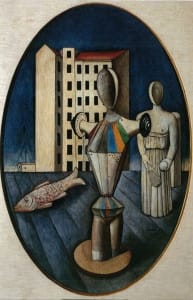
Arts writer Matthew Rudman explains that Carrà and de Chirico "helped to consolidate each other's ideas; they founded the (ultimately short-lived) Metaphysical Art movement, its paintings typified by eerie, dream-like landscapes inspired by classical architecture and incongruous objects accented by perspectival trickery". The metaphysical works of the two artists were similar, though Carrà's were "less sinister" and more tranquil and lighthearted (even at times humorous). However, their engagement with Metaphysical Art, and their friendship, had fizzled out by 1918, shortly after Carrà wrote "Pittura Metafisica", in which he put forward his own more poetic and magical view of the movement's aesthetics. By 1919, Carrà had also taken a special interest in the work of Giotto which began to influence his painting, especially in terms of its stillness and solidity. He also fell in love with the work of French Post-Impressionist painter Henri Rousseau, who, according to Carrà, "more than anyone else had achieved our justifiable desire to guide painting back to its essential purposes".
From 1921, Carrà began to contribute to the Rome based magazine, Valori Plastici (that published under the editorship of Mario Broglio between 1918 and 1922). Although relatively short lived, Valori Plastici was vital in promoting post-war Italian art abroad, not least through the organization of touring exhibitions, such as a 1921 tour of Germany. As art historian Emanuele Greco writes, the magazine played "a decisive role in the European artistic context after WWI. It presented the works of an innovative group of Italian artists including Giorgio de Chirico, Carlo Carrà, Giorgio Morandi, Alberto Savinio, Arturo Martini and Edita Walterowna von Zur Muehlen, who worked to rediscover the roots of their own artistic languages in the Italian Medieval and Renaissance traditions". Greco adds that "The magazine was a remarkable medium for the international spread of Metaphysical painting, that took place when the artists more connected to this style [including Carrá] outdistanced themselves from it in favor of a more naturalistic pictorial language".
Around this period, Carrá, who in his younger years had been an active anarchist , had, in what amounted to a complete ideological U-turn, converted into a nationalist, and became a supporter of the fascist government. He (with sculptors such as Marino Marini and Arturo Martini, and painters such as Felice Casorati and Massimo Campigli) became affiliated with the Novecento Italiano movement that, although it never promoted propagandistic art, was linked to the fascists (in fact the movement was rejected by many fascists who criticized its lack of political focus). Moreover, as art historian Maurizio Fagiolo dell'Arco points out, in the 1920s "Italian fascism was not yet at the stage we cannot forgive. It was in significant ways still the socialist government as which it was elected".
Late Period
Carrà's shifting political and artistic ideas were emergent once more during the early 1930s. He was (between 1926-34) an art critic, writing on such themes as Neoclassicism, for the upmarket Milanese newspaper, The Ambrosiano. In the early 1930s he also joined the fascist Strapaese ("super country") group, founded by Italian painter and printmaker Giorgio Morandi. The pair had in fact met while they were students in Milan and had become friends through their shared interest in Impressionism and Cubism which they learned about from the Italian modern art journal, La Voce. Art critic Xico Greenwald writes that "the myth of Morandi is that the artist kept a low profile as Fascism raged around him" and that he "developed a unique artistic vision, bravely resisting modernism". For his part, Carrà had (like Morandi) "turned away from the arty pretentions of the Metaphysical School" to embrace a style that "glorified Italy's agrarian identity [and] extolled modesty and simplicity in art".
Carrà's reputation has suffered considering his reactionary ultra-nationalist political views which were strongly influenced by fascism and accorded with the neo-classical principles endorsed by Mussolini's regime during the 1930s. These associations have seen his art effectively demonized by critics and historians. But summarizing and exhibition at Florence's Palazzo Strozzi in 2012, "The Thirties: The Arts in Italy Beyond Fascism" (in which Carrà featured), the art critic Alexander Rozhin praised the exhibition because it represented what was an attempt to separate the artworks from the objectionable supremacist worldviews of the artists, what Rozhin called "a fresh look at the artistic culture of this tragic historical period of European civilisation in the 20th century - one with regard to which there has been little variance of opinion to date among its interpreters and judges".
Some works produced by Carrà in the final decades of his life blended stylistic traits from the various movements with which he had been involved during his younger years (namely Futurism, Metaphysical Art and Strapaese art). Between 1941 and 1952 he acted as professor of painting at the Brera Academy, Milan and his professorship coincided (more or less) with a mature painterly style that became somewhat looser with a preference for daubed brushwork. Works such as Landscape in Versilia (1952), and Marina (1953), show an almost impressionistic touch.
The Sorgente Group Foundation says of his final years that "the desire to be simply himself, completely detached from the various artistic currents, led him to focus his attention on a new experimentation: a concept where painting had to be the means to make visible his inner need to identify with nature with a tendency to abstraction, through the simple silent contemplation of a landscape. The isolated places in the countryside or lonely beaches thus became the favorite themes of an almost epic narrative. In these muffled environments, painting transcends itself, becoming the silent language of isolated constructions that the painter transforms into figures".
Carrà died in Milan in 1966. He is buried at the Monumental Cemetery of Milan. His tomb is adorned by a work by the sculptor Giacomo Manzu.
The Legacy of Carlo Carrà
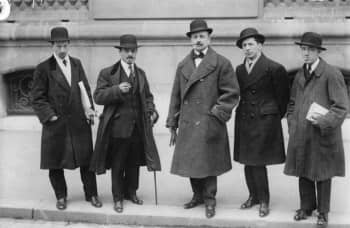
Art historian Andreja Velimirović referred to Carrà "one of the main creative wings behind the visual wonders of Italian Futurism [and] an influential artist who helped shape one of the most important avant-garde movements of the early 20th century". Indeed, Carrà was, with fellow artists Filippo Tommaso Marinetti, Umberto Boccioni, Gino Severini, Giacomo Balla, and Luigi Russolo, a driving force behind the first wave of Italian Futurism. Through a combination of his own art and his influential writing, Carrà gave impetus to the next generation of Italian Futurists including Fortunato Depero and Benedetta Cappa.
Yet, as Phillip Barcio has argued, "More than Futurism, maybe [Metaphysical Painting] was Carrà's greatest legacy; the suggestion that abstraction can be achieved through symbolic or conceptual means, putting objects in contexts that challenge their meaning in an effort to create something new". Its influence on the Surrealists will be obvious to most, but Barcio also notes that probably Carrà's most iconic painting, The Metaphysical Muse (1917), in which "the [painted] target isn't a target [but] an abstract symbol [was] an idea Jasper Johns would explore decades later". Velimirović concludes that, "Although he strayed away from visual concepts on a regular basis for the majority of his career, [Carrà] still managed to leave his mark within every movement he ever worked in. Carrà pioneered concepts, visual vocabularies and artistic movements that changed the face of European art [He] contributed to many aspects of avant-garde societies, engraving his name as one of the most crucial authors of the early 20th century".
Influences and Connections

-
![Henri Rousseau]() Henri Rousseau
Henri Rousseau -
![Giotto]() Giotto
Giotto -
![Pierre-Auguste Renoir]() Pierre-Auguste Renoir
Pierre-Auguste Renoir -
![Paul Cézanne]() Paul Cézanne
Paul Cézanne - Cesare Tallone
-
![Umberto Boccioni]() Umberto Boccioni
Umberto Boccioni -
![Giorgio de Chirico]() Giorgio de Chirico
Giorgio de Chirico ![Luigi Russolo]() Luigi Russolo
Luigi Russolo![Giacomo Balla]() Giacomo Balla
Giacomo Balla
-
![Post-Impressionism]() Post-Impressionism
Post-Impressionism -
![Divisionism]() Divisionism
Divisionism - Trecento
-
![Giorgio Morandi]() Giorgio Morandi
Giorgio Morandi -
![Jasper Johns]() Jasper Johns
Jasper Johns ![Mario Sironi]() Mario Sironi
Mario Sironi- Filippo de Pisis
-
![Umberto Boccioni]() Umberto Boccioni
Umberto Boccioni -
![Giorgio de Chirico]() Giorgio de Chirico
Giorgio de Chirico ![Luigi Russolo]() Luigi Russolo
Luigi Russolo![Giacomo Balla]() Giacomo Balla
Giacomo Balla
 Ask The Art Story AI
Ask The Art Story AI